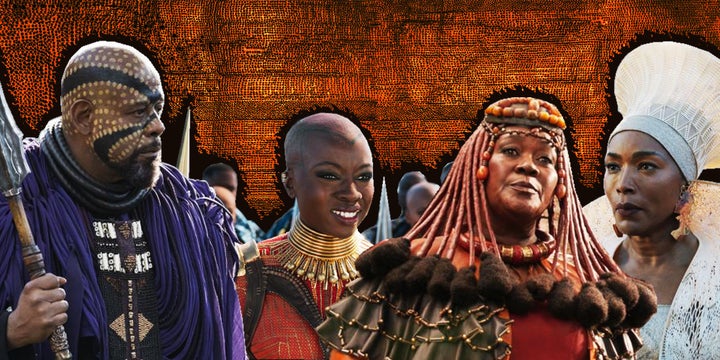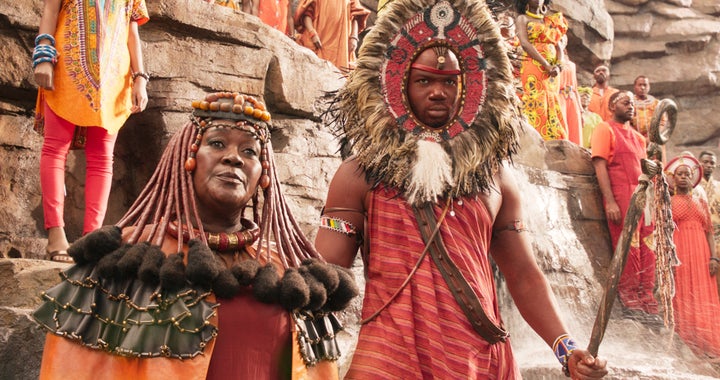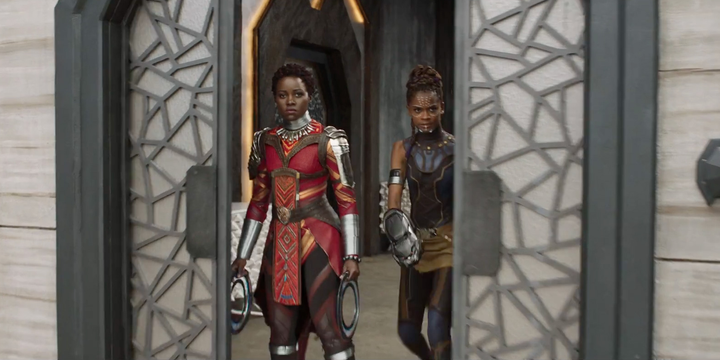
The last time we saw the kind of opulence, grandeur and pure African style displayed in Marvel’s latest box office juggernaut “Black Panther” was, perhaps, 30 years ago, in the classic Eddie Murphy comedy “Coming to America.”
The film overflows with images of Africans looking amazing ― in (lion) furs, in raffia, in blinding gold. Never mind that Zamunda, protagonist Prince Akeem’s birthplace, is not a real country. Never mind that the costumes he and his cohorts wear borrow from all over the continent, from west to east to south Africa.
In “Black Panther,” set in another fictional country, called Wakanda, the depth of traditional African style is even more pronounced. In a pivotal scene at Warrior Falls, we see the entirety of Wakanda and its several tribes on display: Here we have brightly patterned wax prints, neon-colored lip plates, and regal, elaborate headdresses, all incorporating aspects of different African cultures and traditions, visuals that exist beyond the white and Western imagination.

What’s striking about the visual and sartorial elements of “Black Panther,” or “Coming to America” before it, is that its collage-like approach to the African aesthetic has, at times, been a topic of diaspora debate.
Every few years or so, Black Twitter finds itself embroiled in a conversation about the ever-thorny subject of cultural appropriation. The debate usually hinges on what should, ultimately, be a non-question: Can African Americans “appropriate” African culture?
A blog post titled “Black America, Please Stop Appropriating African Clothing and Tribal Marks” that made the rounds in 2017 sparked one of these discussions. The author argued that non-Africans (that is, black Americans with several generations born and raised in America) who wore things like dashikis and cowrie shells were belittling and disrespecting the traditions of African people from the continent.
Ignoring the fact that black Americans and other black people throughout the diaspora are literally descended from Africans, and therefore, African, the author stated:
I would just like you all to realize the hypocrisy of seeing someone wearing a Fulani septum ring, rocking a djellaba, painted with Yoruba-like tribal marks, all the while claiming that this is meant to be respectful. It’s a hodgepodge, a juxtaposition, a right mess of regional, ethnic and cultural customs and it screams ignorance and cultural insensitivity.
The article is just one of many on the subject that claims African Americans and other blacks in the diaspora with no so-called direct ties to Africa are being disrespectful by rocking African styles merely for the aesthetic. These essays claim that black Americans are, in fact, equally as guilty as the white boy rocking dreads or the white girl in kente.
But then a movie like “Black Panther” comes along, and the futility, the absurdity of such a debate is highlighted so vibrantly it makes you want to cry or laugh, or both.
Because aesthetically, “Black Panther” is very much a hodgepodge, a juxtaposition, a mix of regional, ethnic and cultural customs. And that’s part of what makes it so brilliant.
Costume designer Ruth E. Carter, in collaboration with production designer Hannah Beachler, created a “Wakandan Bible” early on in production, a tome that set the standard for “Black Panther” and the inhabitants of its world ― from the Dora Milaje, King T’Challa’s personal body guard, to the Jabari, a clan that lives in the mountains of Wakanda.

“[Before the shoot], I had already been gathering information about the Maasai tribe, and I fell in love with the Dogon,” Carter told HuffPost. “The real Dogon tribe lived in the mountainous area in Africa and they were one of the first astronomers and they studied the stars and they performed a ritual every year where they created these amazing masks that shot up to the heavens. They were carved out of wood and they would adorn their bodies with these raffia skirts and brilliant colors. They were the inspiration for the Jabari tribe.”
Elsewhere in the film, Carter incorporated the traditional painted robes of the Ndebele people of South Africa in the blankets (which are actually shields) worn by Wakanda’s border tribe.
There’s one scene in the movie, in which King T’Challa (Chadwick Boseman), finds himself on the ancestral plane speaking with his dead father. T’Challa wears a tunic with an elaborately embroidered collar, reminiscent of those worn by Yoruba men in Nigeria. When his father appears to him, he is wrapped in traditional cloth in the style that many Ghanaian men do ― indeed the fabric itself is covered in Ghanaian Adinkra symbols for “strength.”
There are many aesthetic moments like this in “Black Panther,” many instances of cultural anachronisms that, somehow, work on another level. There is a flurry of various forms of traditional African attire, from vastly differing parts of the continent. It is, in some ways, nonsensical. In other, more important ways, it makes all the sense in the world. Wakanda is not real in the physical sense, but it is a spiritual ideal, a world representing what the diaspora is and could be if given the chance.
For Carter, the blending of cultures in the film isn’t necessarily about disregarding the significance of the clothes on display.
“Looking at it with modern eyes, it’s OK to pay homage to culture and tradition, but we weren’t trying to make a documentary,” she says. “We wanted to honor it in this futuristic way and a lot of the details of the indigenous African tribes easily translate into a futuristic model.”
Perhaps the most thrilling aspect of Carter’s vision, created alongside Beachler and director Ryan Coogler, is the way it’s being echoed off screen, in theaters across the country (and world) this weekend.
At an opening screening of “Black Panther” in Accra, Ghana, the lobby of a movie theater filled with Ghanaians in their finest kente cloth, as drummers clad in traditional wear joyfully beat hi-life rhythms before the movie began.
The scene was paralleled by an opening night in Harlem, at the Magic Johnson theater, where the lobby was full of black faces and black bodies adorned in kente and dashikis and wax print.
In both theaters, it was so beautifully irrelevant what or who came from where. Because the diasporic tradition of looking good, of showing out, transcends continents, history, time. And that’s what “Black Panther” captures so beautifully.
CORRECTION: A previous version of this story indicated “Coming to America” was released 20 years ago. It was released 30 years ago, in 1988.